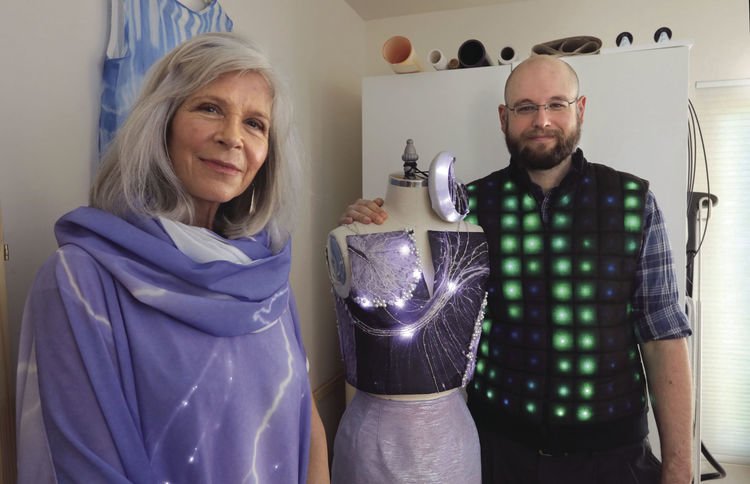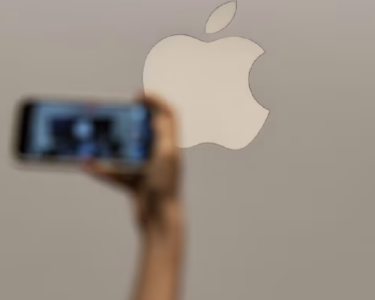In San Diego, there is a mother with passion for fashion designing and her son is a Ph.D. candidate in computer science at UC San Diego. Rachel Merrill and Devon Merrill being family enterpreneurs, have started a new company “Lighted Clothing” that is pushing boundaries in the field of illuminated fashion.
Since their collaboration started about 18 months ago, they have co-created five fashion pieces that incorporate LED lights, fiber optics, hidden batteries and tiny computers that do create streaks of lightning on a dress, moving bands of colour and pics on a vest and waves of glowing light on a skirt that grows brighter when the wearer moves.
Recently, they won a national “Textiles in Technology” award in the “Surface Design Association’s Future Fabrication”, Exhibition in Print 2017. The Merrils were among seven winners chosen from a field of 250 entries by jurors Richard Elliott, who is a textiles expert and professor at the California College of the Arts in Oakland, & “Cathryn Hall”, from the Houston Center for Contemporary Craft.
Concept of illuminated clothing according to Elliott has been around for at least 5 years, but they have taken the tech up a notch in a visually striking way.
Rachel Merrill has enjoyed finding a new way to express her creativity. But she is most happy about collaborating with her 29 year old son.
Rachel and Devon Merrill belong to crafty backgrounds, but they illuminated fashion, and it was not on either of their radars until 2016.
Rachel taught herself sewing in her mid-20s by bringing home Vogue patterns and learning the way to make clothes by trial and error. While Devon developed interest in tinkering from his dad. When he was in high school, Devon was soldering his own home electronics & writing computer code.
Must Read: The 1st automated online wardrobe platform Finseed funds $5 million
The family shares the hobby of hiking. Rachel found her new hobby when she signed up for a fashion design class at San Diego Mesa College in spring 2016.
One of Rachel’s first fashion ideas was Starlight, a hand-dyed blue silk dress having a mesh liner interwoven with seven hundred strands of illuminated superfine filament. There was only one problem that she had no idea how to work with fiber optics, electronic circuits or with computer code.
So she reached out to Devon to get taught about lights, soldering & building circuits. After finishing weaving the fiber liner for Starlight, he built the computerized controller and wrote down the code that creates subtly moving waves of white light.
This looks to be easier than it is. The reason illuminated clothes are not in every store is the danger factor. A miswired circuit could mean a very high risk of fire.
He says: “I’ve burned myself a few times,” , “but I haven’t had a model spontaneously combust yet.”
After Starlight could won best of show in Mesa’s 2016 Golden Scissors Fashion Show, the college’s deptt chair, Susan Lazear, invited Devon to start teaching a seminar class every semester on wearable tech.
Within the first seminar session, the Merrills co-created another project, Wearlight. Rachel designed the black cotton/polyester zip-up vest while Devon implanted it with 96 hidden totally programmable LED 2-inch pixels that could create millions of colours, patterns & pictures. It won 2 awards at Mesa’s next fashion show.
During the last spring, they created Lightning, which was a lavender sheath dress implanted with 4 branched channels of light creating the illusion of a moving lightning storm.
Their biggest project was Light Dance, which is a haute-couture dress built for last fall’s Women & Science fashion gala at the Salk Institute.
Rachel got tasked with creating a dress that was inspired by the work of now-former Salk researcher Hermina Nedelescu, studying the neural pathways in the cerebellum.
Microscopic photos of cells & neurons in the cerebellum had been printed on the dress bodice and decorated with pearls & fine silver chain. The skirt was made from undulating layers of fabric resembling the folds of the brain.
Devon did design the computer controller, hidden in a cerebellum-shaped plastic headpiece, created on a 3D printer. It was connected to the dress through a cable that was running down the model’s spine, the same way the cerebellum does send neural signals to the body. The movement-sensitive ‘cerebellum’ controller did cause the dress lights to glow brighter when the model turned her head or walked.
Their recent project is Illumination, which is a denim vest with a quilted fabric panel designed by Rachel’s sister.




